
King Arthur's family grew throughout the centuries with King Arthur's legend. Many of the legendary members of this mythical king's family became leading characters of mythical tales in their own right.

King Arthur's family grew throughout the centuries with King Arthur's legend. Many of the legendary members of this mythical king's family became leading characters of mythical tales in their own right.

In Welsh Arthurian pre-Galfridian tradition, meaning from before the time of Geoffrey of Monmouth's 12th-century Historia Regum Britanniae (History of the Kings of Britain), Arthur was granted numerous relations and family members. Several early Welsh sources are usually taken as indicative of Uther Pendragon being known as Arthur's father before Geoffrey wrote, with Arthur also being granted a brother (Madog) and a nephew (Eliwlod) in these texts. [1] Arthur also appears to have been assigned a sister in this material – Gwalchmei son of Gwyar is named as his nephew in Culhwch and Olwen , son of his sister and cousin (it does not specify if Gwyar is his father or Arthur's otherwise unknown sister), the Vita Iltuti and the Brut Dingestow combine to suggest that Arthur's own mother was named Eigyr. [2] Culhwch and Olwen also gives Arthur's half-brother as Gormant, son of Arthur's mother and Ricca, the chief elder of Cornwall, a parallel of later stories of Gorlois, Duke of Cornwall. [3]
The genealogies from the 13th-century Mostyn MS. 117 assert that Arthur is the son of Uthyr, the son of Custennin, the son of Cynfawr, the son of Tudwal, the son of Morfawr, the son of Eudaf, the son of Cadwr, the son of Cynan, the son of Caradoc, the son of Bran, the son of Llŷr. Regarding Arthur's own family, his wife is consistently stated to be Gwenhwyfar, usually the daughter of King Ogrfan Gawr (variation: 'Gogrfan Gawr', "[G]Ogrfan the Giant") and sister to Gwenhwyfach, although Culhwch and Bonedd yr Arwyr do indicate that Arthur also had some sort of relationship with Eleirch daughter of Iaen, which produced a son named Kyduan (Cydfan). [4] Kyduan was not the only child of Arthur according to Welsh Arthurian tradition – he is also ascribed sons called Amr (Amhar), [5] Gwydre, [6] Llacheu [7] and Duran. [8] (See the Offspring section for further information about Arthur's children.)
In addition to this immediate family, Arthur was said to have had a great variety of more distant relatives, including maternal aunts, uncles, cousins and a grandfather named Anlawd (or Amlawdd) Wledig ("Prince Anlawd"). The latter is the common link between many of these figures and Arthur: thus the relationship of first cousins that is implied or stated between Arthur, Culhwch, Illtud, and Goreu fab Custennin depends upon all of their mothers being daughters of this Anlawd, who appears to be ultimately a genealogical construct designed to allow such inter-relationships between characters to be postulated by medieval Welsh authors. [9] Arthur's maternal uncles in Culhwch and Olwen, including Llygatrud Emys, Gwrbothu Hen, Gweir Gwrhyt Ennwir and Gweir Baladir Hir, similarly appear to derive from this relationship. [10]

Relatively few members of Arthur's family in the Welsh materials are carried over to the works of Geoffrey of Monmouth and chivalric romancers. His grandfather Anlawd Wledic and his maternal uncles, aunts and cousins do not appear there, and neither do any of his sons or his paternal relatives. Only the core family seem to have made the transition: his wife Gwenhwyfar (who became Guinevere), his father Uthyr (Uther), his mother Eigyr (Igerna), and his sister-son Gwalchmei (Gawain). The place of Gwalchmei's mother Gwyar's was taken by Anna, the wife of Loth, in Geoffrey's account, whilst Modredus (Mordred) was made into her second son (a status he did not have as Medraut in the Welsh material). [11]

In addition, new family members enter the Arthurian tradition from this point onwards. Uther is given a new family, including two brothers and a father, [12] while Arthur gains a sister or half-sister, Morgan, first named as his relative by Chrétien de Troyes in Yvain . [13] A new son of Arthur, named Loholt, is introduced in Chrétien's Erec and Enide . [14] Another significant new family-member is Arthur's other sister or half-sister known by several names including Morgause, daughter of Gorlois and Igerna (Igraine) and mother of Gawain and Mordred, replacing Anna in the romances. They may be joined by a third half-sister, today best known as Elaine. Drawing on earlier sources, Richard Carew mentions another sister from Igraine and Uther, named Amy. [15] The overall number of Arthur's sisters or half-sisters varies between the different romances, ranging from as few as one or two to as many as five (in which case one of them may die early). [16] Their names and roles also vary, as do their husbands (most commonly including the British kings Lot, Urien and Nentres, the last one of them being largely interchangeable with the other two). [lower-alpha 1]
Through the sisters, Arthur is given further nephews (Gawain, Agravain, Gaheris and Gareth by Morgause; Galeschin by Elaine; and Yvain by either Morgan or the fourth sister), who all become Knights of the Round Table. The Brut Tysilio makes Gorlois also the father of Cador, who is thus Arthur's half-brother through Igraine; Cador's son Constantine succeeded Arthur as king of Britain in the Historia Regum Britanniae. Various works mention or feature Arthur's nieces and occasionally also different nephews.
There are furthermore various other more distant family members, such as the case of the historical Romano-British leader Ambrosius Aurelianus being turned into his uncle (Uther's brother) in Geoffrey's tradition deriving Arthur's lineage from the self-proclaimed Western Roman Emperor Constantine II of Britain, who in this version of the legend is presented as Arthur's grandfather. One important figure of no actual blood relation to Arthur is Ector, featuring as secret foster-father of the young Arthur in much of the romance tradition, thus also making Ector's son Kay Arthur's foster brother.
Although Arthur is given sons in both early and late Arthurian tales, he is rarely granted significant further generations of descendants. This is at least partly because of the premature deaths of his sons, who in the later tradition usually (and prominently) include Mordred. In some cases, including in Le Morte d'Arthur , [18] Guinevere's failure to produce a legitimate heir contributes to the fall of Arthur.
In the early Welsh tradition, Mordred (Medraut) was merely a nephew of Arthur, who had three different sons; however, their stories are largely lost. Amr is the first to be mentioned in Arthurian literature, appearing in the 9th-century Historia Brittonum :
There is another wonder in the region which is called Ercing. A tomb is located there next to a spring which is called Licat Amr; and the name of the man who is buried in the tomb was called thus: Amr. He was the son of Arthur the soldier, and Arthur himself killed and buried him in that very place. And men come to measure the grave and find it sometimes six feet in length, sometimes nine, sometimes twelve, sometimes fifteen. At whatever length you might measure it at one time, a second time you will not find it to have the same length – and I myself have put this to the test. [19]
Why Arthur chose or was forced to kill his son is never made clear. The only other reference to Amr comes in the post-Galfridian Welsh romance Geraint , where "Amhar son of Arthur" is one of Arthur's four chamberlains along with Bedwyr's son Amhren. [20] : 231
Gwydre is similarly unlucky, being slaughtered by the giant boar Twrch Trwyth in Culhwch and Olwen, along with two of Arthur's maternal uncles. No other references to either Gwydre or Arthur's uncles survive. [21] [20] : 132, 134
Another son, known only from a possibly 15th-century Welsh text, is said to have died on the field of Camlann:
More is known of Arthur's son Llacheu. He is one of the "Three Well-Endowed Men of the Island of Britain", according to the Triad 4, and he fights alongside Cei in the early Arthurian poem Pa gur yv y porthaur? . [23] Like his father is in Y Gododdin , Llacheu appears in the 12th-century and later Welsh poetry as a standard of heroic comparison and he also seems to have been similarly a figure of local topographic folklore too. [24] Taken together, it is generally agreed that all these references indicate that Llacheu was a figure of considerable importance in the early Arthurian cycle. [25] Nonetheless, Llacheu too dies, with the speaker in the pre-Galfridian poem Ymddiddan Gwayddno Garanhir ac Gwyn fab Nudd remembering that he had "been where Llacheu was slain / the son of Arthur, awful in songs / when ravens croaked over blood." [26] The romance character based on him, Lohot, also dies young.
Mordred is a major exception to this tradition of a childless death for Arthur's sons. Mordred, like Amr, is killed by Arthur – at Camlann – according to Geoffrey of Monmouth and the post-Galfridian tradition but, unlike the others, he is ascribed two sons, both of whom rose against Arthur's successor and cousin Constantine III with the help of the Saxons. However, in Geoffrey's Historia (when the motifs of Arthur's killing of Mordred and Mordred's sons first appear), Mordred was not Arthur's son. [27] His relationship with Arthur was reinterpreted in the Vulgate Cycle, as he was made the result of an unwitting incest between Arthur and his sister. [28] This tale is preserved in the later romances, with the motif of Arthur knowing by Merlin that Mordred would grow up to kill him; and so by the time of the Post-Vulgate Cycle Arthur has devised a plot, Herod-like, to rid of all children born on the same day as Mordred in order to try to save himself from this fate. [29] The Post-Vulgate version also features another of Arthur's illegitimate sons, Arthur the Less, who survives for as long as Mordred but remains fiercely loyal to Arthur.
Other literature has expanded Arthur's immediate family further. His daughter named Archfedd is found in only one Welsh source, the 13th-century Bonedd y Saint . [30] A daughter named Hilde is mentioned in the 13th-century Icelandic Þiðreks saga (Thidrekssaga), while the Möttuls saga from around the same period features a son of Arthur by the named Aristes. The eponymous Samson the Fair from another Norse work, Samsons saga fagra , is Arthur's son as well. Rauf de Boun's 1309 Petit Brut lists Arthur's son Adeluf III as a king of Britain, also mentioning Arthur's other children Morgan le Noir (Morgan the Black) and Patrike le Rous (Patrick the Red) by an unnamed Fairy Queen. [31] Later on, a number of early modern works have occasionally given Arthur more of different sons and daughters. [lower-alpha 2]
Supposed direct lineage from King Arthur has been professed by some English monarchs, especially the ones of Welsh descent, among them the 15th-century King Henry VII (through Cadwaladr ap Cadwallon [32] ), who even named his first-born son after Arthur, and the 16th-century Queen Elizabeth I. [33] In the Scottish Highlands, the descent from King Arthur remains included in rival genealogies of both Clan Arthur (MacArthur) and Clan Campbell, [34] whose traditions involve Arthur's son variably known as Merbis, Merevie, Smerbe, Smerevie or Smereviemore (according to the Campbells, from his second marriage to a French princess named Elizabeth [35] ). [36] In Iberia, medieval and early modern genealogies attributed Queen Baddo, wife of the 6th-century Visigothic King Reccared I, as a daughter of British King Arthur. [37]

Excalibur is the mythical sword of King Arthur that may possess magical powers or be associated with the rightful sovereignty of Britain. Traditionally, the sword in the stone that is the proof of Arthur's lineage and the sword given him by a Lady of the Lake are not the same weapon, even as in some versions of the legend both of them share the name of Excalibur. Several similar swords and other weapons also appear within Arthurian texts, as well as in other legends.

King Arthur is a legendary king of Britain, and a central figure in the medieval literary tradition known as the Matter of Britain.
Creiddylad, daughter of King Lludd, is a minor character in the early medieval Welsh Arthurian tale Culhwch ac Olwen.

Gawain, also known in many other forms and spellings, is a character in Arthurian legend, in which he is King Arthur's nephew and one of the premier Knights of the Round Table. The prototype of Gawain is mentioned under the name Gwalchmei in the earliest Welsh sources. He has subsequently appeared in many Arthurian tales in Welsh, Latin, French, English, Scottish, Dutch, German, Spanish, and Italian, notably as the protagonist of the Middle English poem Sir Gawain and the Green Knight. Other works featuring Gawain as their central character include De Ortu Waluuanii, Diu Crône, Ywain and Gawain, Golagros and Gawane, Sir Gawain and the Carle of Carlisle, L'âtre périlleux, La Mule sans frein, La Vengeance Raguidel, Le Chevalier à l'épée, Le Livre d'Artus, The Awntyrs off Arthure, The Greene Knight, and The Weddynge of Syr Gawen and Dame Ragnell.

Uther Pendragon (Brittonic), also known as King Uther, was a legendary King of the Britons and father of King Arthur.

Mordred or Modred is a figure in the legend of King Arthur. The earliest known mention of a possibly historical Medraut is in the Welsh chronicle Annales Cambriae, wherein he and Arthur are ambiguously associated with the Battle of Camlann in a brief entry for the year 537. Medraut's figure seemed to have been regarded positively in the early Welsh tradition and may have been related to that of Arthur's son.
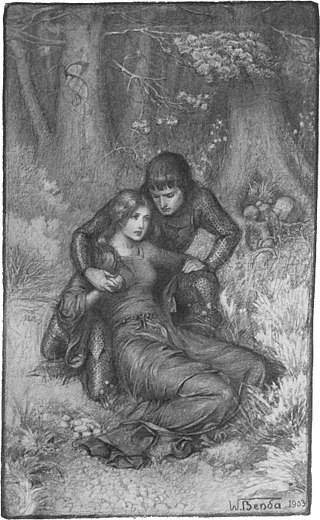
In the Matter of Britain, Igraine is the mother of King Arthur. Igraine is also known in Latin as Igerna, in Welsh as Eigr, in French as Ygraine, in Le Morte d'Arthur as Ygrayne—often modernised as Igraine or Igreine—and in Parzival as Arnive. She becomes the wife of Uther Pendragon, after the death of her first husband, Gorlois.

Bedivere is one of the earliest characters to be featured in the legend of King Arthur, originally described in several Welsh texts as the one-handed great warrior named Bedwyr Bedrydant. Arthurian chivalric romances, inspired by his portrayal in the chronicle Historia Regum Britanniae, portray Bedivere as a Knight of the Round Table of King Arthur who serves as Arthur's marshal and is frequently associated with his brother Lucan and his cousin Griflet as well as with Kay. In the English versions, Bedivere notably assumes Griflet's hitherto traditional role from French romances as the one who eventually returns Excalibur to the Lady of the Lake after Arthur's last battle.
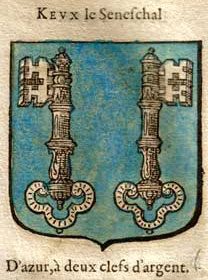
In Arthurian legend, Kay is King Arthur's foster brother and later seneschal, as well as one of the first Knights of the Round Table. In later literature he is known for his acid tongue and bullying, boorish behaviour, but in earlier accounts he was one of Arthur's premier warriors. Along with Bedivere, with whom he is frequently associated, Kay is one of the earliest characters associated with Arthur. Kay's father is called Ector in later literature, but the Welsh accounts name him as Cynyr Ceinfarfog.
Morgause, Queen of Orkney, is a character in Arthurian legend in which she is the mother of Gawain and Mordred, both key players in the story of King Arthur and his downfall.

King Lot, also spelled Loth or Lott, is a British monarch in Arthurian legend. He was introduced in Geoffrey of Monmouth's pseudohistorical Historia Regum Britanniae as King Arthur's brother-in-law, who serves as regent of Britain between the reigns of Uther Pendragon and Arthur. He has appeared regularly in works of chivalric romance, alternating between the roles of Arthur's enemy and ally, and is often depicted as the ruler of Lothian and either Norway or Orkney. His literary character is probably derived from hagiographical material concerning Saint Kentigern, which features Leudonus as king of Leudonia and father of Saint Teneu.
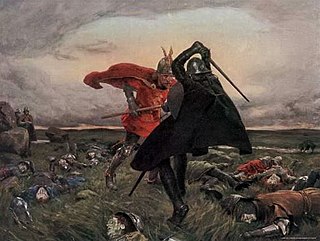
The Battle of Camlann is the legendary final battle of King Arthur, in which Arthur either died or was fatally wounded while fighting either alongside or against Mordred, who also perished. The original legend of Camlann, inspired by a purportedly historical event said to have taken place in the early 6th-century Britain, appears only in vague mentions found in several medieval Welsh texts dating since around the 10th century. The battle's much more detailed depictions have emerged since the 12th century, generally based on that of a catastrophic conflict described in the pseudo-chronicle Historia Regum Britanniae. The further greatly embellished variants originate from the later French chivalric romance tradition, in which it became known as the Battle of Salisbury, and include the 15th-century telling in Le Morte d'Arthur that remains popular today.
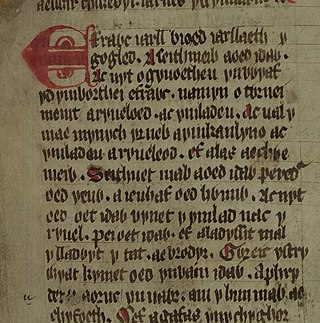
Peredur is the name of a number of men from the boundaries of history and legend in sub-Roman Britain. The Peredur who is most familiar to a modern audience is the character who made his entrance as a knight in the Arthurian world of Middle Welsh prose literature.
Constantine was a 6th-century king of Dumnonia in sub-Roman Britain, who was remembered in later British tradition as a legendary King of Britain. The only contemporary information about him comes from Gildas, who castigated him for various sins, including the murder of two "royal youths" inside a church. The historical Constantine is also known from the genealogies of the Dumnonian kings, and possibly inspired the tradition of Saint Constantine, a king-turned-monk venerated in Southwest Britain and elsewhere.
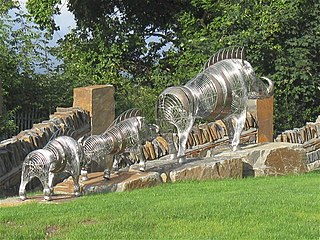
Twrch Trwyth, is a fabulous wild boar from the Legend of King Arthur, of which a richly elaborate account of its hunt described in the Welsh prose romance Culhwch and Olwen, probably written around 1100.
Pridwen was, according to the 12th-century writer Geoffrey of Monmouth, King Arthur's shield; it was adorned with an image of the Virgin Mary. Geoffrey's description of it draws on earlier Welsh traditions found in Preiddeu Annwfn, Culhwch and Olwen, and the Historia Brittonum. The shield is also named and described by Wace, Layamon, Roger of Wendover and Robert of Gloucester among other medieval writers, and it directly inspired the description of Sir Gawain's shield in Sir Gawain and the Green Knight.

Edern ap Nudd was a knight of the Round Table in Arthur's court in early Arthurian tradition. As the son of Nudd, he is the brother of Gwyn, Creiddylad, and Owain ap Nudd. In French romances, he is sometimes made the king of a separate realm. As St Edern, he has two churches dedicated to him in Wales.

Caradoc Vreichvras was a semi-legendary ancestor to the kings of Gwent. He may have lived during the 5th or 6th century. He is remembered in the Matter of Britain as a Knight of the Round Table, under the names King Carados and Carados Briefbras.
Amlawdd Wledig was a legendary king of sub-Roman Britain. The Welsh title [G]wledig, archaically Gwledic or Guletic and Latinised Guleticus, is defined as follows: "lord, king, prince, ruler; term applied to a number of early British rulers and princes who were prominent in the defence of Britain about the time of the Roman withdrawal; (possibly) commander of the native militia ".
Rhongomyniad, or Rhongomiant, was the spear of King Arthur in the Welsh Arthurian legends. Unlike Arthur’s two other weapons, his sword Caledfwlch and his dagger Carnwennan, Rhongomyniad has no apparent magical powers.
{{cite book}}: CS1 maint: location missing publisher (link)